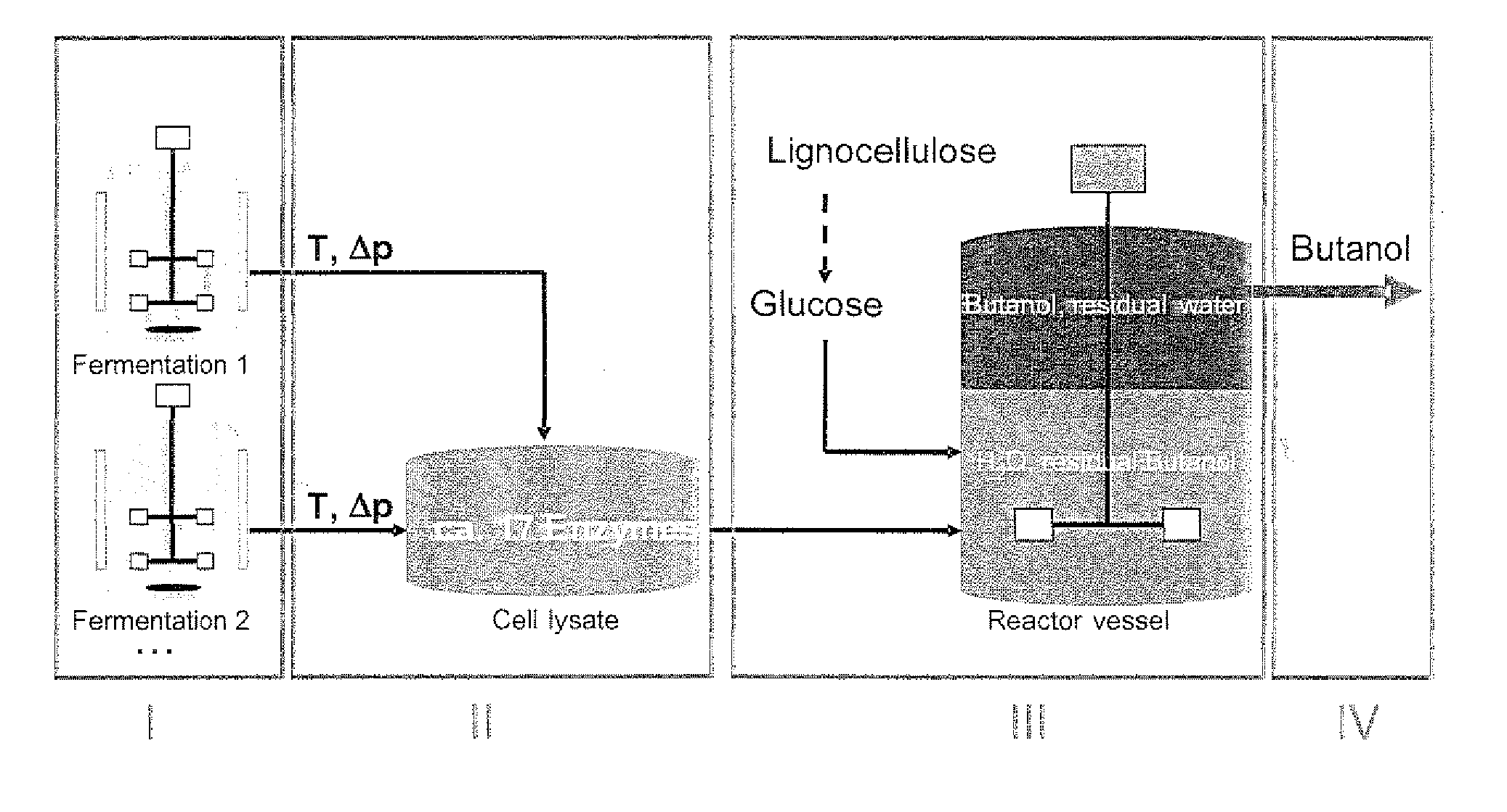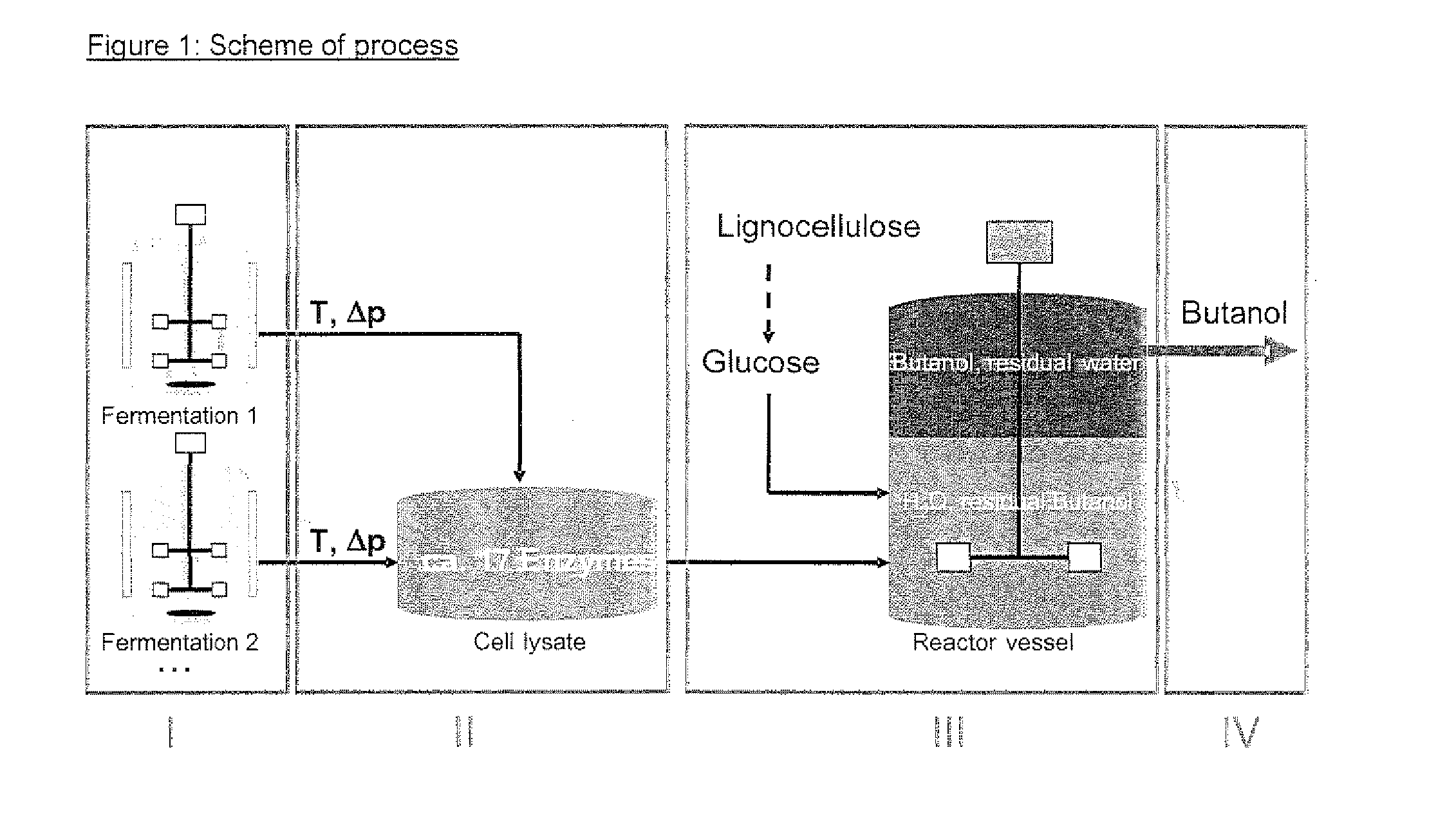Process for cell-free production of chemicals
- Summary
- Abstract
- Description
- Claims
- Application Information
AI Technical Summary
Benefits of technology
Problems solved by technology
Method used
Image
Examples
example 1
Conversion of Glucose to N-Butanol Using Enzyme Mixtures from Cell Lysates of C. saccharobutylicum, S. cerevisae and Z. mobilis
[0126]S. cerevisae is grown anaerobically at 30° C. on YPD-medium containing 12% glucose. The formation of ethanol is monitored by sampling every hour and analysis by gas chromatography. In a phase of highest ethanol productivity the cells are harvested and suspended with 4× volume of reaction buffer (20 mM potassium phosphate, pH 6.5; 5 mM mercaptoethanol, 10 mM NaCl, 10 mM MgSO4, 500 μM ZnSO4, 500 μM CoCl2, 200 μM MnCl2). Cells are then lysed by disruption in a French press, the cell supernatant is clarified by centrifugation and filtersterilized to remove any remaining cells.
[0127]Z. mobilis (ATCC10998) is grown at 35° C. on LB medium containing 12% glucose. The formation of Ethanol is monitored by sampling every hour and analysis by gas chromatography. In a phase of highest ethanol productivity the cells are harvested and suspended with 4× volume of rea...
example 2
Conversion of Glucose to N-Butanol Using Isolated Enzymes and Enzymes from Cell Lysates of C. Saccharobutylicum
[0130]The cell lysate of C. saccharobutylicum from example 1 is incubated with the following enzymes: hexokinase (20 u / ml), phosphohexoisomerase (15 u / ml), phosphofructokinase (4 u / ml), aldolase (16 u / ml), phosphotrioseisomerase (300 u / ml), glycerinaldehyd-3-phosphat-dehydrogenase (60 u / ml), phosphoglycerate kinase (120 u / ml), phosphoglycerate mutase (60 u / ml), enolase (11 u / ml), pyruvatkinase (15 u / ml), pyruvat dehydrogenase (20 u / ml), phosphotransacetylase (15 u / ml) (all enzymes obtained from Sigma, see table below, only phosphoglycerate mutase obtained from USB, 26111 Miles Road, Cleveland Ohio, Product number 26118 100 UG, human enzyme recombinantly expressed in E. coli). Incubation is done in 20 mM potassium phosphate, pH 6.5; 5 mM mercaptoethanol, 10 mM NaCl, 10 mM MgSO4, 500 μM ZnSO4, 500 μM CoCl2, 200 μM MnCl2, 4 mM ATP, 1 mM ADP, 1 mM NADH, 1 mM NAD, 1 mM Coenzyme...
example 3
Conversion of Glucose to N-Butanol Using Isolated Enzymes
[0131]The enzymes Thiolase (EC 2.3.1.16, Clostridium acetobutylicum, NCBI-GenID NP—349476.1), 3-hydroxybutyryl-CoA dehydrogenase (EC 1.1.1.157, NP—349314.1), Crotonase (EC 4.2.1.55, Clostridium acetobutylicum, NP—349318.1), Butyryl-CoA dehydrogenase (EC 1.3.99.2, Clostridium acetobutylicum, NCBI-GenID NP—349317.1), Coenzyme A acylating aldehyde dehydrogenase (EC 1.2.1.57, Clostridium beijerinckii, NCBI-GenID AF132754—1), NADH-dependent butanol dehydrogenase B (BDH II) (EC 1.1.1.-, Clostridium acetobutylicum, NCBI-GenID NP—349891.1) and an electron transfer flavoprotein (etfA and B, Clostridium acetobutylicum, NCBI-GenID NP—349315.1 and NP—349316.1) are synthesized and recombinantly expressed in E. coli as described. All enzymes are combined (1 mg each) in a 5 ml reaction solution (20 mM potassium phosphate, pH 6.5; 5 mM mercaptoethanol, 10 mM NaCl, 10 mM MgSO4, 500 μM ZnSO4, 500 μM CoCl2, 200 μM MnCl2, 4 mM ATP, 1 mM ADP, 1 mM...
PUM
 Login to View More
Login to View More Abstract
Description
Claims
Application Information
 Login to View More
Login to View More - R&D
- Intellectual Property
- Life Sciences
- Materials
- Tech Scout
- Unparalleled Data Quality
- Higher Quality Content
- 60% Fewer Hallucinations
Browse by: Latest US Patents, China's latest patents, Technical Efficacy Thesaurus, Application Domain, Technology Topic, Popular Technical Reports.
© 2025 PatSnap. All rights reserved.Legal|Privacy policy|Modern Slavery Act Transparency Statement|Sitemap|About US| Contact US: help@patsnap.com


